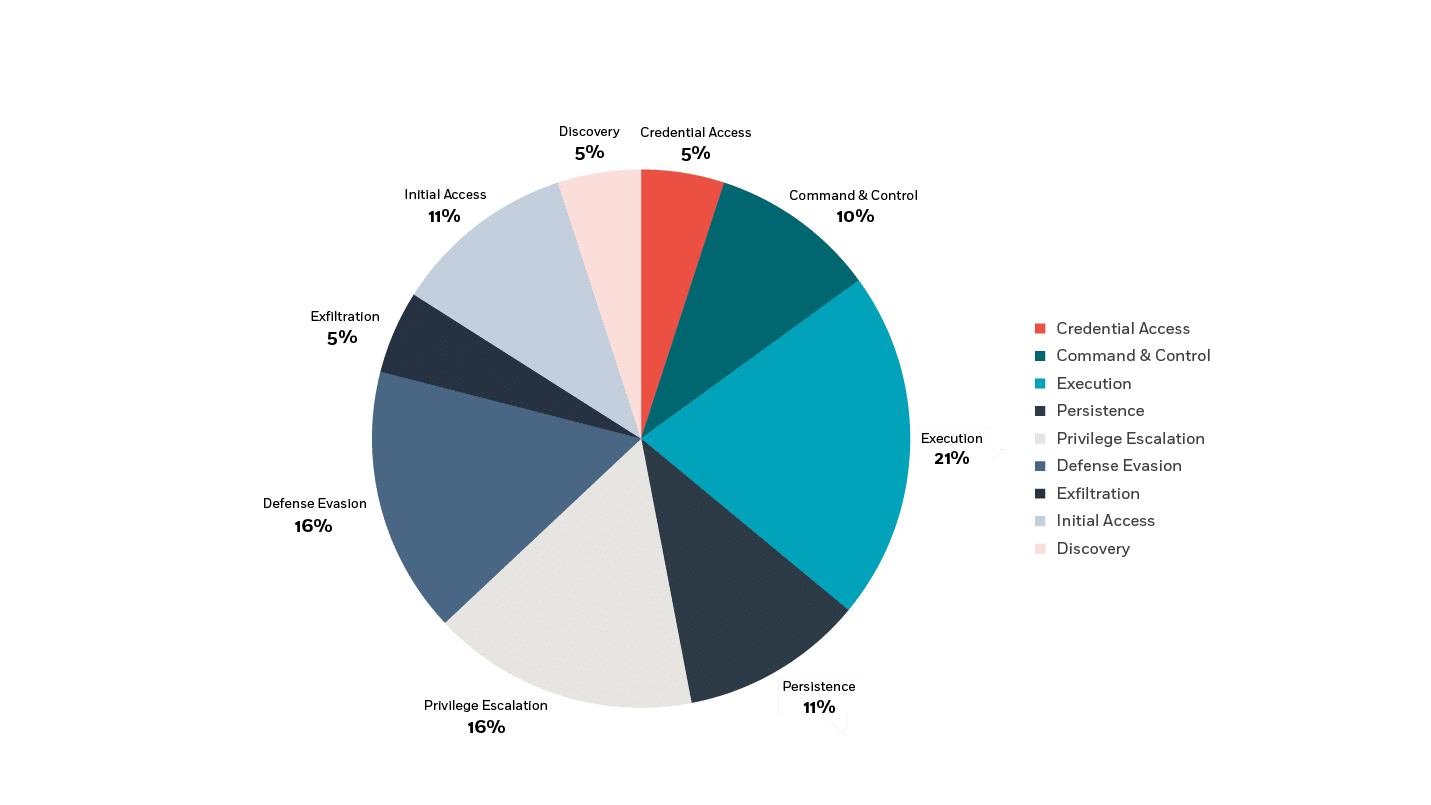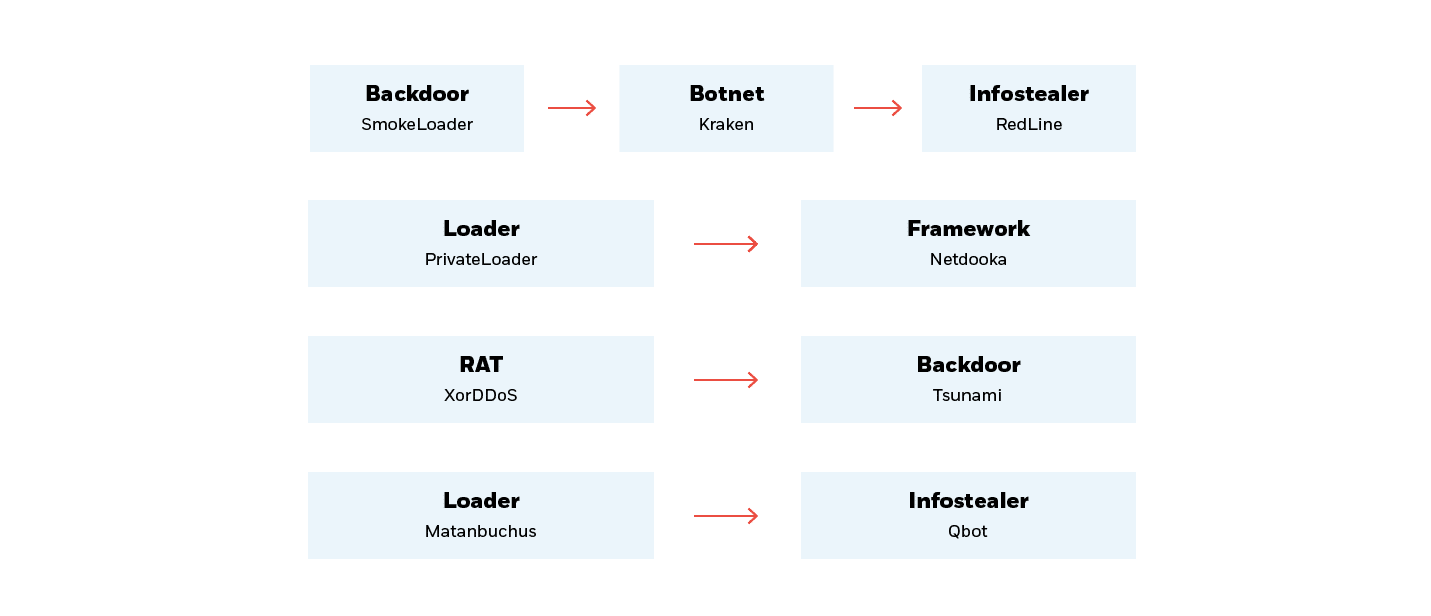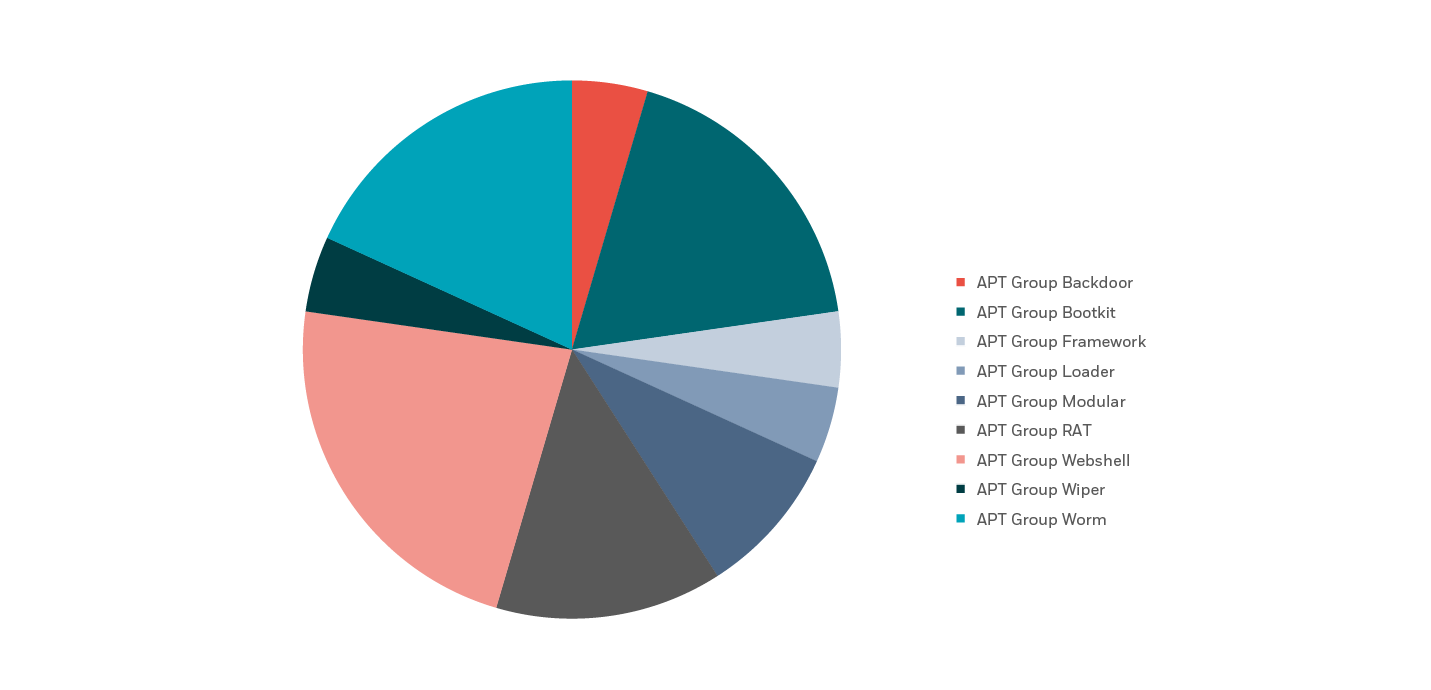2022’s arrival was plagued by real-world events including the ongoing COVID-19 pandemic and the inception of the Russian-Ukrainian conflict. These events were coupled with a flurry of high-profile cyber-related threats – with widespread Log4Shell and Follina exploitations chief among them.
Threat actors keep up with current events and advancements in technology and leverage the opportunities they represent. Alongside more methodical and calculated approaches that attackers take, they also incorporate current events into campaigns and attack chains.
While many types of attackers fall under the ever-blossoming threat actor umbrella, this post seeks to take a focused snapshot of the malware-related threat landscape from January to July 2022. Its aim is to attempt to analyze malware usage and trends as observed through the lens of a CyberProof analyst whose objective is to provide threat intelligence solutions to enterprise-level clients.
Alongside more methodical and calculated approaches that attackers take, they also incorporate current events into campaigns and attack chains.
MITRE techniques observed in malware attacks
In our research, the CyberProof CTI Team identified the following 15 MITRE techniques as most commonly employed in malware attacks:
|
Technique/Sub-technique |
Tactic |
|
Application Layer Protocol: Web Protocols |
Command and Control |
|
Scheduled Task/Job: Scheduled Task |
Execution/Persistence/Privilege Escalation |
|
Obfuscated Files or Information |
Defense Evasion |
|
Ingress Tool Transfer |
Command and Control |
|
Exfiltration Over C2 Channel |
Exfiltration |
|
Command and Scripting Interpreter: PowerShell |
Execution |
|
User Execution: Malicious File |
Execution |
|
Phishing: Spearphishing Link |
Initial Access |
|
Phishing: Spearphishing Attachment |
Initial Access |
|
Process Injection |
Defense Evasion/Privilege Escalation |
|
Command and Scripting Interpreter: Windows Command Shell |
Execution |
|
System Information Discovery |
Discovery |
|
Boot or Logon Autostart Execution: Registry Run Keys / Startup Folder |
Persistence / Privilege Escalation |
|
Credentials from Password Stores: Credentials from Web Browsers |
Credential Access |
|
Obfuscated Files or Information: Software Packing |
Defense Evasion |
MITRE tactics
The MITRE techniques that were used were related to the following tactics:
- 21% of MITRE techniques used are related to Execution
- 16% pertain to Privilege Escalation
- 16% are related to Defense Evasion
A comparative analysis of data collected in previous years highlights an interesting trend: data collected by external sources in the first half of 2020 show a large uptick in Scheduled Task usage, alongside a decrease in the volume of malware attacks using Process Injection.
Interestingly, PowerShell exploitation has remained relatively consistent, and is constantly being observed in attacks.

Top Mitre Techniques

Unraveling the adversaries’ motivation – User Execution
Now that we’ve laid out the top MITRE techniques used this year, we can attempt to understand why they were the most popular.
First, let’s explore why malware was used most often for execution purposes. This notion is supported by several pieces of evidence:
- Wiper malware – harnessed by threat actors hellbent on data destruction – is the most prominent type of malware utilized in the Russia-Ukraine conflict. It is one of the most prominent types of malware that we’ve observed over the course of the last six months.
- APT groups have had the most individual malware strains attributed to their use. Seeing as these groups are acting to achieve a larger goal, their endgame usually culminates in user execution.
- Completely unattributed attacks – the “average Joes” of malware attacks – are most likely to have no ulterior motives save for user execution.
Why Defense Evasion techniques are so prevalent
Bearing in mind the fact that 21% of MITRE techniques used were related to Execution – we can now try to figure out why Defense Evasion techniques were common. Generally, attackers nowadays are more inclined to bide their time and remain undetected for longer periods of time. This is underscored by the following:
- The CyberProof CTI Team observed an increasing number of malware strains that “managed to remain undetected,” are “elusive,” or have “gone under the radar.” The uptick in detecting such malware supports our initial hypothesis of a rise in more covert behavior from attackers – as seen for example with Symbiote and Tarrask.
- Attackers are incorporating advanced evasion techniques leveraging public cloud services such as Azure and AWS as part of their campaigns. Aside from obsoleting the need to host their own servers and maintain their infrastructure, this also acts as a cloaking mechanism for attempted attacks. We’ve seen this type of approach incorporated in ASyncRAT, Nanocore, and Netwire campaigns.
- Attackers are simply becoming smarter, more patient, and more up to date with new technology and the opportunities it presents. This extends to extensive usage of native Windows command-line and scripting tools such as PowerShell and VBScript.
Attackers nowadays are more inclined to bide their time and remain undetected for longer periods of time.
Top malware strains
In 2022, the CyberProof CTI Team reported:
- Qbot-related campaigns were most frequent
- Emotet and RedLine incidents came in second place
- ASyncRAT, Cyclops Blink, IcedID, Mars, and PrivateLoader campaigns rounded out the rest of the top eight
Qbot-related campaigns were most frequent, Emotet and RedLine incidents came in second place, ASyncRAT, Cyclops Blink, IcedID, Mars, and PrivateLoader campaigns rounded out the rest of the top eight.
It’s worth noting that RATs and Infostealers each comprise 37.5% of the top eight, with Modular malware and Loaders making up 12.5% each.
Modular malware – such as wipers – saw a significant boost during the first half of 2022 due to its major role in attacks on Ukrainian organizations.

Top Malware

Top Malware Types
Additional insight into the most prevalent types of malware
We can attribute the fact that RATs and infostealers were the most prevalent pieces of malware to the following causes:
- The prevalence of readily available infostealers on black market forums lowers the technical bar for newcomers, so greater numbers of adversaries are using them. AgentTesla and Netwire are prime examples of this.
- A surge in publicly available loaders makes it significantly easier to drop niche malware and technically unsophisticated malware. Matanbuchus and PrivateLoader are such loaders.
QBot and Emotet remain some of the heavy hitters in today’s field. Extensive previous experience in running their respective operations, as well as a solid technological infrastructure, enables them to resume their operations unfettered.
Trickbot is interestingly absent from the top malware strains reported since the malware operation shut down in February 2022.
The rest of the top eight are comprised primarily of other infostealers and RATs, alongside the leftfield modular CyclopsBlink which played a major role in attacks on Ukrainian assets in the Russia-Ukraine conflict, as well as the PII loader PrivateLoader.
Malware trends & new techniques observed in 2022
As technology evolves – and as the technological infrastructure used by victims changes with the times – threat actors are quick to exploit and incorporate potential newfound “blind spots” as part of their attack chains.
The CyberProof Cyber Threat Intelligence (CTI) Team singled out the following emerging trends and new techniques that we expect to see more of in the second half of 2022 and beyond.
|
Malware |
Technique |
Description |
|
Moonbounce |
Targeting endpoints’ UEFI |
This malware is the third-most widely known malware delivery through UEFI bootkit found in the wild. |
|
Qakbot |
Using new attack vectors |
Using MSI Windows Installer packages as an infection vector is a first for Qbot operators, as Qbot is known to deliver payloads via malicious, macro-laced Microsoft Office attachments in phishing emails. |
|
RedLine Infostealer |
Coinciding with real-world events |
The infostealers’ operators were seen leveraging Windows 11’s launch announcement to carry out attacks that coincided with the moment that Microsoft announced its broad deployment phase. |
|
RedLine |
Leveraging long-forgotten vulnerabilities and methods |
RedLine was dropped via RIG exploit kits, even though such kits have dropped drastically in popularity. |
|
ASyncRAT Netwire Nanocore IcedID |
Incorporating public cloud infrastructure |
Threat actors are increasingly using cloud technologies to achieve their objectives without having to resort to hosting their own infrastructure. IcedID abused both Google Cloud and Google Firebase to deliver phishing links. |
|
BazarLoader |
Shifting familiar attack patterns |
Threat actors were observed spreading malware via website contact forms as opposed to spreading via typical phishing emails. |
|
Malicious NPM packages |
Targeting a particular group of interest |
The CyberProof CTI Team observed a large-scale campaign targeting Azure developers. In general, we have seen several campaigns where malicious NPM packages have been uploaded to popular library archives. |
|
Denonia |
Deployed in attacks targeting AWS Lambda environments with cryptominers |
The first known malware to specifically target AWS Lambda environments. |
|
Spyder XMRig |
Targeting unique technologies |
Spyder was deployed in attacks targeting AMD devices. XMRig was dropped in a campaign targeting exposed Docker Engine API endpoints. |
Linking different pieces of malware
While researching the threat landscape, the CTI Team found it difficult to pinpoint the exact method threat actors might use to deliver the malicious payloads. Below is a non-exhaustive flowchart that showcases how the current delivery chain has no clear distribution pattern.
Between loaders dropping frameworks, RATs dropping backdoors, and other combinations – each threat actor working with complete agency to fulfill their own objectives – we find ourselves up against an ever-shifting “Wild West” of malware distribution.

Various delivery chains
Malware types used by APT, FIN and UNC groups
Looking at malware distribution per threat actor type, we see that APT groups utilize a wider array of malware types in comparison to other group types by quite a large margin.
This makes sense as APT groups usually have a myriad of agendas, all using different means to achieve them. This stands in stark contrast to FIN groups, for example, who are only interested in financial profit.
Some of the types of malware that we observed being used by APT groups exclusively include:
- Frameworks
- Bootkits
- Modular Malware
- Webshells
- Worms
While FIN groups were the only ones using cryptominers and APT groups were the only ones using wipers, the UNC groups have no “signature” malware.
Malware types used by different kinds of threat actors
By taking a deeper dive into specific types of malware and how they’re being leveraged by certain threat actors, we can see that loaders and RATs are being evenly employed by all types of groups, while wiper malware is being used almost only by APT groups – save for a single UNC group that is a suspected APT.
In contrast, backdoors saw use by all types of threat actors – though their use was heavily skewed towards APT groups. While APT groups were observed using backdoors in 50% of reported incidents, FIN groups were seen using them over 37% of the time.



Malware used by UNC groups
Tailored threat intelligence provides insight
At CyberProof, the CTI team tracks which malware types are used by different kinds of threat actors and focuses on revealing emerging trends and new techniques that we expect to be seeing in the future.
Particular kinds of actors can be expected to use specific malware strains – such as backdoors or modular malware. Gaining an understanding of what types of malware attacks are most likely to be utilized is an important step toward mitigating an attack’s business impact.
Interested in speaking with a member of our CTI team? Contact us today!











